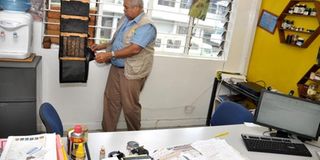At home with bees in my office

African BeeKeepers Limited Managing Director Ernest Simeoni displaying a beehive in his office during an interview in Nairobi on the May 26, 2014. PHOTO | GERALD ANDERSON
What you need to know:
- Any ordinary person would dread bee stings and would not want to be near them, but not for Simeoni, the managing director of African Bee Keepers.
- The office hive, as well as vast experience in the sector, has enabled Simeoni to gather knowledge on particular types of African Bees and honey production patterns in the region.
When you meet Ernest Simeoni, it is easy to identify where his heart is – in bees.
His shirts have an embroidery of a bee on the lapel, which Simeoni admits is because of his love for bees.
And hanging on the wall of his office are charts and graphs of different things about bees. Then there is a jar of honey and honey combs at a table in the medium-sized office.
On his computer monitor, Simeoni has hanged a plastic bee that sways as winds blow into the room.
His love for bees does not end there. Simeoni keeps bees in his office, located in Nairobi’s Industrial Area.
Connected to the beehive placed on a shelf in the office is a pipe that runs out of the room.
“That is the passage for the bees. They use it to get in and out of the hive for them to make honey,” says Simeoni.
Any ordinary person would dread bee stings and would not want to be near them, but not for Simeoni, the managing director of African Bee Keepers.
“I love bees so much that I have to stay near them every day. Bees have made me who I am. They give me my daily bread. I will never forsake them.”
His passion for bees began in 1994 when his wife challenged him to try a tender that called for supply of honey to a certain institution.
Simeoni took up the challenge, which later saw him introduce the Langstroth beehive, which has been accepted internationally.
He later set up the first commercial factory, Honey Care International Limited, to manufacture and produce high quality beehives and related gadgets. He now produces 1,000 beehives each month.
So, why does he keep the hive in his office?
“It is because of my love for bees. But that aside, this hive is dear to me. It is my barometer. It tells me when I should go and harvest honey from the other hives,” says Simeoni with a chuckle.
He also uses the hive to demonstrate to visitors how to keep bees.
“With the bees here, they tell me whether nectar is available or not. By simply peeking into the combs, I monitor the honey production process as well as bee patterns and behaviours. I have learnt that bees will fan their honey so that it dries before closing the combs.
Therefore, honey harvested is void of humidity and this is the honey we produce here.”
The office hive, as well as vast experience in the sector, has enabled Simeoni to gather knowledge on particular types of African Bees and honey production patterns in the region.
“I have studied the local flora that produces nectar flowers in different zones of Kenya and the flowering seasons. This enables me to plan honey production accurately.”
His firm produces bee hives that he sells across the country.
The hives are made of several partitions. These include the brooder, which houses the queen and is separated by a mesh from the upper box where worker bees make the honey.
The mesh stops the queen from accessing the upper box, where she could lay eggs that could be destroyed during honey harvesting. “The honey combs during harvesting are taken out in the upper box, which is immediately replaced with a new one, so that the bees can continue making honey. As honey from each box is emptied with a machine, the combs are left intact and can be used again.”
From each hive, the farmer gets about 30kg of honey alongside bees wax. “We get the honey, remove it from the combs and as thick and fresh as it is, we package it into sterilised containers. No additive or refining is needed.”
The recycling of honey combs is advantageous to bees as they make honey faster since they don’t have to build new ones after every harvest.
“The African bee is very aggressive, but we make friendlier hives. Thus, bees make honey with little disturbance.”
While he advises that bee farming is a good investment, he clarifies: “There are only two seasons of honey in a year. This is pegged on the long or short rains seasons. In addition, bee farming is not about bees only. It involves the study of flowers as a bee can travel a radius of about 4km to search for nectar. Areas with sunflower plants and acacia forests are optimal environments for nectar production.
Other forage varieties are eucalyptus, coffee, oranges, and bananas. Nonetheless, bee farming can be carried out anywhere provided these factors are considered.”
He notes that apiculture is a low cost venture but with high returns. “With an initial investment of Sh100,000, one is able to get a startup kit that has about 10 hives. Bee keeping is a great venture particularly to self-help groups.”
In addition to selling the Langstroth hive and honey, the company trains farmers on managing hives and they buy wax and honey from bee keepers.
In his about two decades experience in bee farming, Simeone faces some challenges in the venture.
“Not many people are into bee farming. Therefore, there is no one to refer to and to a lot extent, we have to localise international bee farming practices.”




